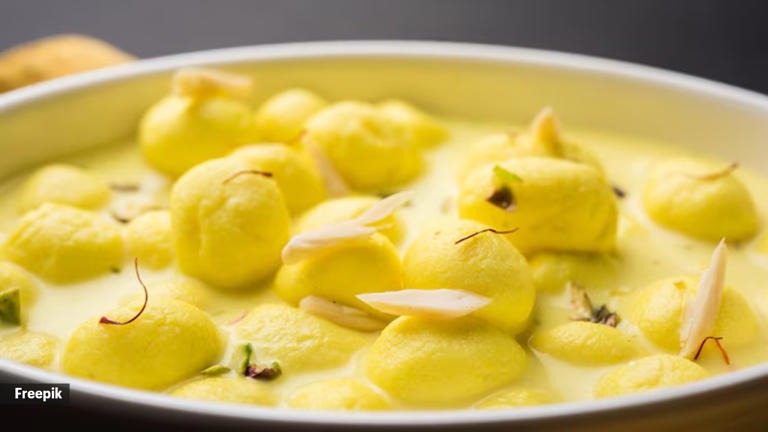Learn about its origins, cultural significance, and how to make your own Rasmalai at home! (Source: Freepik)
The world of cheese desserts extends far beyond the realm of creamy New York-style cheesecakes. From ricotta-filled cannoli to the gooey delight of French cheese fondue, cheese offers a surprising versatility in the realm of sweet treats. But recently, a challenger to the cheesecake throne has emerged — the Indian dessert Rasmalai.
Ranked second in the world’s best cheese desserts by Taste Atlas, Rasmalai is captivating hearts (and taste buds) around the globe.
So, what makes Rasmalai so special?
The key lies in its unique cheese — chhena. Unlike aged cheeses used in cheesecakes, chhena is a fresh cheese made from curdling milk with lemon juice or vinegar. The resulting curds are light and airy, forming the base of the soft, spongy balls that are the heart of Rasmalai.
These chenna balls are then simmered in a light sugar syrup before being bathed in the star of the show — Rabdi — a rich, thickened milk flavoured with cardamom, nuts, and sometimes even saffron.
Rasmalai’s name itself translates to ‘juicy cream’, a fitting description for this dessert. Talking about the history behind the dish, chef Shaurya Veer Kapoor of Gola Sizzlers, Cafe Hawkers and Sambar Soul restaurant, says that it is believed to have originated in the Bengal region of the Indian subcontinent.
Kolkata-based confectioners, K.C Das Grandsons, claim their founder, Krishna Chandra Dasm invented Rasmalai in the early 20th century. Food historian K.T Achaya supports this claim, suggesting Das built upon his father’s creation of Rasgulla (chenna balls) to develop Rasmalai.
However, Bangladesh’s Comilla district throws another twist into the story. The Sen brothers of Matri Bhandar claim to be the original creators, emphasising their role in popularising and commercialising the dessert. They’ve even applied for a Geographical Indication (GI) tag for ‘Comillar Rosmalai’.
“The exact historical details are not well-documented, but Rasmalai is said to be developed around the 19th century,” explains chef Kapoor. “It is closely related to another popular Bengali dessert, Rasgulla,” he adds.
However, Rasmalai transcends its role as a mere dessert — holding a deep cultural significance in the Indian subcontinent — as it weaves itself into the fabric of South Asian traditions.
“Rasmalai is a ubiquitous presence during festivals and special occasions. Its sweetness symbolises prosperity and indulgence, making it a fitting way to mark joyous events like Diwali, Holi and weddings,” chef Kapoor says.
Not only this. Its rich, creamy texture and contrasting flavours represent a luxurious treat. “Rasmalai becomes a special occasion dessert, reserved for moments of celebration and shared enjoyment,” adds chef Kapoor.
Rasmalai is a ubiquitous presence during festivals and special occasions. (Source: Freepik)
Here’s a recipe of Rasmalai that can be easily made at home, courtesy chef Kapoor:
Ingredients
*2 litres full-fat milk
*¼ cup lemon juice
*½ cup sugar
*4 cups water
*A pinch of saffron strands (optional)
*1 tablespoon chopped pistachios or almonds (for garnishing)
Method
1. Make the chenna balls:
*In a heavy-bottomed pan, bring 1 litre of milk to a boil.
*Once boiling, reduce heat to low and gradually add lemon juice while stirring continuously until the milk curdles completely, separating the whey from the milk solids (paneer). A little extra lemon juice can be added if curdling is incomplete.
*Turn off heat and let it cool for a few minutes.
2. Drain the paneer:
*Line a strainer or muslin cloth over a bowl and strain the curdled milk.
*Rinse the paneer under cold water to remove any lemon juice residue.
*Squeeze out excess water and hang the paneer for 30 minutes to remove any remaining liquid.
3. Knead and shape the paneer:
*After draining, knead the paneer on a clean surface for 5-7 minutes until it becomes smooth and soft.
*Divide the paneer dough into small, equal-sized portions and shape them into balls. Gently press each ball to flatten them slightly.
4. Cook the paneer balls:
*In another wide pan, combine water and sugar. Bring it to a boil and ensure the sugar dissolves completely.
*Gently slide the paneer balls into the boiling syrup. Cover and cook for 15-20 minutes on medium heat, allowing the balls to double in size.
5. Make the Rabdi and assemble:
*While the balls cook, in a separate pan, heat the remaining 1 litre of milk and add saffron strands (if using). Let it simmer for a few minutes, allowing it to thicken slightly.
*Once the paneer balls are cooked, turn off the heat and let them cool in the syrup.
*Gently squeeze out any excess syrup from the cooled balls and transfer them to the thickened milk.
*Let them soak in the refrigerator for at least an hour.
*Garnish with chopped pistachios or almonds.







So delicious 😋…I must try this recipe in holi